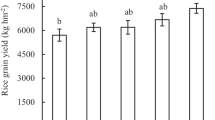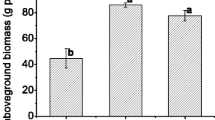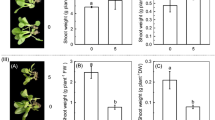Abstract
Cadmium (Cd) contamination in soil is an increasingly serious problem. Management of plant nutrients has been proposed as a potentially promising strategy for minimizing Cd accumulation in crops grown in contaminated soil. This study investigated the effects of split applications of nitrogen (N) fertilizers on the Cd concentration in Chinese cabbage (Brassica chinensis L.) plants grown in Cd-contaminated soil. Compared with single applications, split applications of ammonium or urea resulted in significantly lower Cd concentrations, and higher biomass production and antioxidant-associated nutritional quality in the edible plant parts. However, when nitrate was used as the N fertilizer, there were no significant differences between the split and single applications for the same parameters. We conclude that a split application could be more beneficial than a single application method when ammonium or urea is used as the N fertilizer for vegetable cultivation in Cd-contaminated soil.
摘要
目 的
研究不同形态氮肥的分次施用对小白菜镉积累、 产量及品质的影响, 并初步分析了其作用机制。
创新点
首次提出尿素、 铵态氮和硝态氮肥料的分次施用方式可提升镉污染土壤上的作物安全生产。
方 法
选用尿素、 硫酸铵和硝酸钙等 3 种常用氮肥, 通过盆栽试验, 比较了这 3 种肥料的分次施用方法和一次性施用方法对小白菜的镉含量、 生物量以及营养品质的影响。
结 论
在镉污染的条件下, 与一次性施肥相比, 尿素和硫酸铵的分次施肥方法显著降低了小白菜可食部位的镉含量, 增加了可食部位的生物量并改善了抗氧化相关的营养品质指标; 然而, 当硝酸钙作为氮肥时, 小白菜可食部位的镉含量、 生物量以及抗氧化相关的营养品质指标在两种不同的施肥方法之间并无统计学上的显著差异。因此, 在镉污染的土壤上, 当硫酸铵或尿素作为氮肥时, 分次施肥方法比一次性施肥方法更加有利于保障蔬菜的安全生产与品质改善。
Similar content being viewed by others
References
Abu-Amsha, R., Croft, K.D., Puddey, I.B., et al., 1996. Phenolic content of various beverages determines the extent of inhibition of human serum and low-density lipoprotein oxidation in vitro: identification and mechanism of action of some cinnamic acid derivatives from red wine. Clin. Sci., 91(4): 449–458. http://dx.doi.org/10.1042/cs0910449
Bao, S.D., 2008. Soil Agro-chemistrical Analysis. China Agriculture Publishing House, Beijing, China, p.14–69 (in Chinese).
Chen, W., Luo, J.K., Shen, Q.R., 2005. Effect of NH4 +-N/NO3 −-N ratios on growth and some physiological parameters of Chinese cabbage cultivars. Pedosphere, 15(3): 310–318.
Clemens, S., Aarts, M.G.M., Thomine, S., et al., 2013. Plant science: the key to preventing slow cadmium poisoning. Trends Plant Sci., 18(2): 92–99. http://dx.doi.org/10.1016/j.tplants.2012.08.003
Crawford, N.M., Glass, A.D.M., 1998. Molecular and physiological aspects of nitrate uptake in plants. Trends Plant Sci., 3(10): 389–395. http://dx.doi.org/10.1016/S1360-1385(98)01311-9
de Ruijter, F.J., ten Berge, H.F.M., Smit, A.L., 2010. Strategies to increase nitrogen use efficiency and reduce nitrate leaching in vegetable production in the Netherlands. Acta Hortic., 852: 107–114. http://dx.doi.org/10.17660/ActaHortic.2010.852.11
Dheri, G.S., Brar, M.S., Malhi, S.S., 2007. Influence of phosphorus application on growth and cadmium uptake of spinach in two cadmium-contaminated soils. J. Plant Nutr. Soil Sci., 170(4): 495–499. http://dx.doi.org/10.1002/jpln.200625051
Dong, J., Mao, W.H., Zhang, G.P., et al., 2007. Root excretion and plant tolerance to cadmium toxicity—a review. Plant Soil Environ., 53(5): 193–200.
Florijn, P.J., Nelemans, J.A., van Beusichem, M.L., 1992. The influence of the form of nitrogen nutrition on uptake and distribution of cadmium in lettuce varieties. J. Plant Nutr., 15(11): 2405–2416. http://dx.doi.org/10.1080/01904169209364483
Fraga, C.G., Motchnik, P.A., Shigenaga, M.K., et al., 1991. Ascorbic acid protects against endogenous oxidative DNA damage in human sperm. Proc. Natl. Acad. Sci. USA, 88(24): 11003–11006. http://dx.doi.org/10.1073/pnas.88.24.11003
Frankel, E.N., Waterhouse, A.L., Teissedre, P.L., 1995. Principal phenolic phytochemicals in selected California wines and their antioxidant activity in inhibiting oxidation of human low-density lipoproteins. J. Agric. Food Chem., 43(4): 890–894. http://dx.doi.org/10.1021/jf00052a008
Gillam, K.M., Zebarth, B.J., Burton, D.L., 2008. Nitrous oxide emissions from denitrification and the partitioning of gaseous losses as affected by nitrate and carbon addition and soil aeration. Can. J. Soil Sci., 88(2): 133–143. http://dx.doi.org/10.4141/CJSS06005
Hanneken, A., Lin, F.F., Johnson, J., et al., 2006. Flavonoids protect human retinal pigment epithelial cells from oxidative-stress-induced death. Invest. Ophth. Vis. Sci., 47(7): 3164–3177. http://dx.doi.org/10.1167/iovs.04-1369
He, P., Lu, Y.H., Liang, Y.H., et al., 2013. Exposure assessment of dietary cadmium: findings from Shanghainese over 40 years, China. BMC Public Health, 13: 590. http://dx.doi.org/10.1186/1471-2458-13-590
Herman, D.J., Johnson, K.K., Jaeger, C.H., et al., 2006. Root influence on nitrogen mineralization and nitrification in Avena barbata rhizosphere soil. Soil Sci. Soc. Am. J., 70(5): 1504–1511. http://dx.doi.org/10.2136/sssaj2005.0113
Hinsinger, P., Plassard, C., Tang, C.X., et al., 2003. Origins of root-mediated pH changes in the rhizosphere and their responses to environmental constraints: a review. Plant Soil, 248(1): 43–59. http://dx.doi.org/10.1023/A:1022371130939
Hurrell, R.F., 2003. Influence of vegetable protein sources on trace element and mineral bioavailability. J. Nutr., 133(9): 2973s–2977s.
Jin, C.W., Du, S.T., Wang, Y., et al., 2009. Carbon dioxide enrichment by composting in greenhouses and its effect on vegetable production. J. Plant Nutr. Soil Sci., 172(3): 418–424. http://dx.doi.org/10.1002/jpln.200700220
Jin, C.W., Liu, Y., Mao, Q.Q., et al., 2013. Mild Fe-deficiency improves biomass production and quality of hydroponiccultivated spinach plants (Spinacia oleracea L.). Food Chem., 138(4): 2188–2194. http://dx.doi.org/10.1016/j.foodchem.2012.12.025
Kirkham, M.B., 2006. Cadmium in plants on polluted soils: effects of soil factors, hyperaccumulation, and amendments. Geoderma, 137(1–2): 19–32. http://dx.doi.org/10.1016/j.geoderma.2006.08.024
Kurbacher, C.M., Wagner, U., Kolster, B., et al., 1996. Ascorbic acid (vitamin C) improves the antineoplastic activity of doxorubicin, cisplatin, and paclitaxel in human breast carcinoma cells in vitro. Cancer Lett., 103(2): 183–189. http://dx.doi.org/10.1016/0304-3835(96)04212-7
López-Bellido, L., López-Bellido, R.J., Redondo, R., 2005. Nitrogen efficiency in wheat under rainfed Mediterranean conditions as affected by split nitrogen application. Field Crop. Res., 94(1): 86–97. http://dx.doi.org/10.1016/j.fcr.2004.11.004
Lotito, S.B., Frei, B., 2006. Consumption of flavonoid-rich foods and increased plasma antioxidant capacity in humans: cause, consequence, or epiphenomenon? Free Radical Biol. Med., 41(12): 1727–1746. http://dx.doi.org/10.1016/j.freeradbiomed.2006.04.033
Luo, B.F., Du, S.T., Lu, K.X., et al., 2012. Iron uptake system mediates nitrate-facilitated cadmium accumulation in tomato (Solanum lycopersicum) plants. J. Exp. Bot., 63(8): 3127–3136. http://dx.doi.org/10.1093/jxb/ers036
Lux, A., Martinka, M., Vaculik, M., et al., 2011. Root responses to cadmium in the rhizosphere: a review. J. Exp. Bot., 62(1): 21–37. http://dx.doi.org/10.1093/jxb/erq281
Mao, Q.Q., Guan, M.Y., Lu, K.X., et al., 2014. Inhibition of nitrate transporter 1.1-controlled nitrate uptake reduces cadmium uptake in Arabidopsis. Plant Physiol., 166(2): 934–944. http://dx.doi.org/10.1104/pp.114.243766
Perfus-Barbeoch, L., Leonhardt, N., Vavasseur, A., et al., 2002. Heavy metal toxicity: cadmium permeates through calcium channels and disturbs the plant water status. Plant J., 32(4): 539–548. http://dx.doi.org/10.1046/j.1365-313X.2002.01442.x
Prince, W.S., Kumar, P.S., Doberschutz, K.D., et al., 2002. Cadmium toxicity in mulberry plants with special reference to the nutritional quality of leaves. J. Plant Nutr., 25(4): 689–700. http://dx.doi.org/10.1081/PLN-120002952
Sanchez-Moreno, C., 2002. Review: methods used to evaluate the free radical scavenging activity in foods and biological systems. Food Sci. Technol. Int., 8(3): 121–137. http://dx.doi.org/10.1177/1082013202008003770
Sarwar, N., Saifullah, Malhi, S.S., et al., 2010. Role of mineral nutrition in minimizing cadmium accumulation by plants. J. Sci. Food Agric., 90(6): 925–937. http://dx.doi.org/10.1002/jsfa.3916
Sempeho, S.I., Kim, H.T., Mubofu, E., et al., 2014. Meticulous overview on the controlled release fertilizers. Adv. Chem., 2014: 1–16. http://dx.doi.org/10.1155/2014/363071
Shaviv, A., 2001. Advances in controlled-release fertilizers. Adv. Agron., 71: 1–49. http://dx.doi.org/10.1016/S0065-2113(01)71011-5
Shyamala, B.N., Gupta, S., Lakshmi, A.J., et al., 2005. Leafy vegetable extracts—antioxidant activity and effect on storage stability of heated oils. Innov. Food Sci. Emerg., 6(2): 239–245. http://dx.doi.org/10.1016/j.ifset.2004.12.002
Tsadilas, C.D., Karaivazoglou, N.A., Tsotsolis, N.C., et al., 2005. Cadmium uptake by tobacco as affected by liming, N form, and year of cultivation. Environ. Pollut., 134(2): 239–246. http://dx.doi.org/10.1016/j.envpol.2004.08.008
Tudoreanu, L., Phillips, C.J.C., 2004. Modeling cadmium uptake and accumulation in plants. Adv. Agron., 84: 121–157. http://dx.doi.org/10.1016/S0065-2113(04)84003-3
Wei, B.G., Yang, L.S., 2010. A review of heavy metal contaminations in urban soils, urban road dusts and agricultural soils from china. Microchem. J., 94(2): 99–107. http://dx.doi.org/10.1016/j.microc.2009.09.014
Zaccheo, P., Crippa, L., Pasta, V.D.M., 2006. Ammonium nutrition as a strategy for cadmium mobilisation in the rhizosphere of sunflower. Plant Soil, 283(1): 43–56. http://dx.doi.org/10.1007/s11104-005-4791-x
Zerulla, W., Barth, T., Dressel, J., et al., 2001. 3,4-Dimethylpyrazole phosphate (DMPP)—a new nitrification inhibitor for agriculture and horticulture. Biol. Fert. Soils, 34(2): 79–84. http://dx.doi.org/10.1007/s003740100380
Author information
Authors and Affiliations
Corresponding author
Additional information
Project supported by the National Key Research and Development Project of China (No. 2016YFD0200103), the National Natural Science Foundation of China (Nos. 31622051 and 31670258), and the Zhejiang Provincial Natural Science Foundation of China (No. LR13C130001)
Electronic supplementary material
Rights and permissions
About this article
Cite this article
Fan, Sk., Zhu, J., Tian, Wh. et al. Effects of split applications of nitrogen fertilizers on the Cd level and nutritional quality of Chinese cabbage. J. Zhejiang Univ. Sci. B 18, 897–905 (2017). https://doi.org/10.1631/jzus.B1600272
Received:
Accepted:
Published:
Issue Date:
DOI: https://doi.org/10.1631/jzus.B1600272




